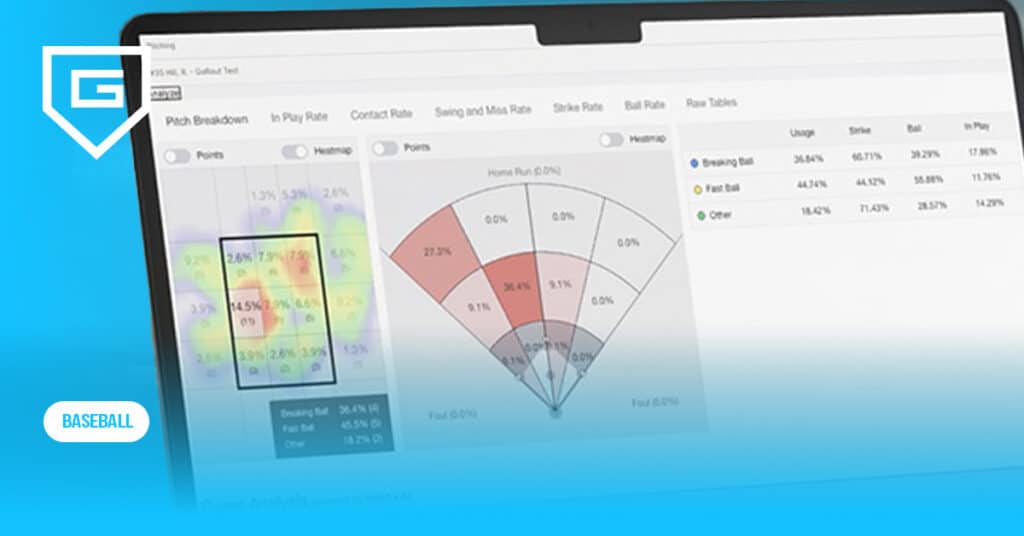Youth Softball Practice Plans: Building Winning Teams with GoRout Diamond
Reading Time: 12 minutes
Reading Time: 12 minutes
Youth softball coaches can build winning teams with GoRout Diamond by using structured practice plans that boost skill development, teamwork, and game readiness.
This article provides step-by-step youth softball practice plans, highlights the benefits of GoRout Diamond for efficient coaching, and shares tips for maximizing player engagement and performance from practice to game day.
Why Do Youth Softball Practice Plans Matter?

Youth softball practice plans help you give every kid the right mix of structure, learning, and fun. Whether your group is just starting out or already has some experience, good planning helps every athlete develop softball skills, teamwork, and confidence.
Practices planned ahead make a big difference, especially for younger age groups. Short attention spans can make random drills tough, but having set activities means you keep everyone focused and moving.
Here’s how structured practice plans support your team:
- Every practice covers the essential skills your players need most
- You can track who is improving and who needs extra help
- Kids know what to expect, which helps them feel safe and ready to learn
Organized practices also help build confidence and teamwork. When kids work together to complete drills, play mini-games, or rotate through stations, they learn to communicate and trust each other.
A simple practice plan supports all skill levels. You can make drills easier or harder, depending on your athletes’ abilities.
This keeps advanced players challenged and gives beginners a chance to succeed. Introducing new drills and activities every few weeks helps maintain player engagement and prevents monotony.
For coaches, a written plan ensures you stay on track and don’t waste time figuring out your next step.
Using a tool like GoRout Diamond helps you keep sessions focused and adjust for different groups during practice.
How to Start With Pre-season and Seasonal Planning
Pre-season and seasonal planning help you create youth softball practice plans that keep your team on track and ready to compete.
Start by setting smart goals before the season starts. Do you want to improve players’ hitting, help them learn new positions, or just have fun and build skills?
Writing down your hopes helps guide your actions each week. A flexible, long-term practice calendar lets you adjust as your team grows.
Here’s a simple way to map out your season.
| Week | Focus Skill | Team Goal |
| 1-2 | Basic fundamentals | Building basic throwing, fielding, and batting techniques |
| 3-4 | Fielding, hitting, and throwing drills | Gain valuable repetitions practicing the techniques and skills from first two weeks |
| 5-6 | Drills and game situations | Prepare for game action by continuing drills and incorporating game-like situations and scrimmages |
| 7-8 | Drills and scrimmages | Maintain fundamentals and correct issues identified in games |
| 9-10 | Review/Playoffs | Continue correcting any issues identified in games and prepare for playoff competition |
Mix skill drills with fun games to keep players engaged. Update or rotate drills every few weeks to maintain player interest and prevent routines from becoming stale.
Try to balance competition and skill development with team-building activities. Let your players have fun and bond while working toward your team’s goals.
How to Make Comprehensive Youth Softball Practice Plans

Balance makes an effective softball practice plan. Make sure you cover basics like catching and pitching but also use drills that challenge both beginners and advanced players. Practices built this way help everyone improve faster.
Below is a sample breakdown.
| Time | Activity |
| 0-10m | Dynamic warm-up |
| 10-30m | Fielding drills |
| 30-50m | Hitting/throwing drills |
| 50-60m | Team defense situations |
When planning, think about what your players need to work on the most. Rotate stations and keep activities short to keep energy high.
Dividing drills into multiple rounds can help maximize repetitions and skill development during each practice.
Even when you have to adjust for bad weather or absences, having a solid plan lets you switch to indoor drills or focus on smaller groups. This flexibility keeps your practices productive and your players motivated.
Key Equipment For Effective Youth Softball Practice Plans
To run effective youth softball practices, you need the right mix of equipment. Reliable gear helps your team move quickly between drills and keeps players safe. It also makes sure practices run smoothly.
You’ll want to start with the basics—softballs, bats, helmets, and buckets for easy access. Having extra balls on hand keeps drills flowing with quick transitions.
Must-have youth softball equipment includes:
- Balls: Multiple softballs for different types of drills and warmups.
- Bats: A mix of sizes so every player can use one that fits.
- Buckets: Used to store balls and speed up cleanup.
- Batting tees and hitting nets: Key for structured batting practice.
- Cones: Helpful for marking drill zones and practice stations.
- Stopwatches: Used for timing sprints, drills, or baserunning exercises.
While these basic tools are key for any practice, they can only take a team so far.
Advanced tech solutions like GoRout Diamond improve your training by simplifying communication, enhancing in-practice efficiency, and helping teams execute drills with precision.
With GoRout Diamond, coaches and players stay connected on the field—leading to smarter practices and better game-day results.
Let’s explain how.
GoRout Diamond softball pitch calling system

The GoRout Diamond softball pitch calling system is the most advanced, in-game-compliant solution for seamless communication on the diamond.
Designed for coaches and players, GoRout Diamond eliminates missed signs, miscommunication, and signal stealing, ensuring your team stays one step ahead.
Key features for coaches

Coaches can use the intuitive web app to easily build and customize offensive and defensive plays, which sync directly with the mobile coaches app for real-time game management.
This integrated platform makes it simple to instantly send pitch calls, defensive shifts, and offensive plays with just one touch using the GoRout coaches app.
The system is fully customizable, allowing position-specific messaging and unlimited updates throughout the year.
Built-in AI analytics and real-time pitch charting provide powerful insights, including pitch intent vs. result data.
Key features for players

Players receive clear, encrypted instructions on durable, weatherproof devices that require no setup or pairing.
The display is easily visible in any lighting condition, and a four-way privacy screen protects each device for secure communication.
Team benefits

GoRout Diamond improves team efficiency, eliminates confusion, and improves on-field performance.
With no WiFi required—thanks to GoRout Air™ cellular technology—your team is always connected, rain or shine.
Devices boast a battery life of at least 12 hours on a single charge, allowing them to stay operational through extended games or doubleheaders.
You can fully recharge them in under one hour for a quick turnaround.
GoRout offers flexible packages to fit any budget or program size, starting with a single NFHS-approved device for coach-to-catcher communication and expanding as needed.
It comes with a 100% warranty to cover any damages. Testimonials and case studies are also available for those interested in learning more about its proven impact.
Ready to upgrade your youth softball program?
Visit GoRout Diamond to get a quote or shop now!
Safety equipment checklist
Keeping players safe is always a top priority. It’s important to have:
- Helmets with face guards for batters
- Catcher’s gear (mask, chest protector, shin guards)
- First aid kit by the field
- Hydration station to keep everyone cooled off
Make safety a part of every practice and game—not an afterthought.
Top Drills to Include in Your Youth Softball Plans
Strong practice plans focus on key skills: throwing, fielding, hitting, and baserunning. The best youth softball drills improve technique while keeping things fun and engaging.
Warm-up and throwing drills for youth softball
| Drill Name | What to Do | Why It Matters |
| Warm-Up Jog/Skip | Begin each practice with light jogging or skipping. | Warms up muscles, reduces injury risk, and boosts energy. |
| Stretching Routine | Stretch arms, legs, and shoulders after warming up. | Improves flexibility and prepares muscles for throwing. |
| Wrist Snap Drill | Focus on proper use of the throwing hand and follow-through for better control. | Teaches proper form and mechanics for beginners. |
| Partner Throwing | Helps players practice making throws with precision using proper arm mechanics. | Builds throwing accuracy and catching technique. |
| Long Toss | Players gradually increase throwing distance in pairs. | Develops arm strength and throwing endurance. |
| Throw Around the Diamond | Infielders throw quickly to each base in sequence, forming a circle. | Enhances speed, accuracy, and teamwork. |
Infield drills to master ground balls
| Drill Name | What to Do | Why It Matters |
| Alligator Hands | Field ground balls with one hand above and one below the ball while scooping. | Players learn to build proper glove technique and ball control. |
| Ready Position Drill | Start with knees bent, glove low, eyes up, fingers point toward the ball. | Reinforces good fielding posture and glove positioning. |
| Short Hop Toss | Toss tennis balls for players to field quick short hops. | Improves reflexes and footwork for unpredictable bounces. |
| Grounder Line Drill | Line up players and hit grounders directly at them, then to both sides. | Trains consistency, lateral movement, and reaction time. |
| Shuffle & Center | Players shuffle feet to center themselves before throwing. | Encourages body control and accurate throws. |
| Fielding Challenge | Challenge players to field five balls cleanly in a row. Use cones as targets for throws. | Makes fielding practice competitive while boosting accuracy and focus. |
Outfield drills for young players
| Drill Name | What to Do | Why It Matters |
| Drop Step Drill | Players face forward, then quickly open hips and run back to track fly balls over their shoulder. | Develops reaction time and tracking skills on deep balls. |
| Pop Fly Practice | Toss tennis balls or softballs for overhead catches—start easy, increase difficulty gradually. | Builds confidence and coordination for catching fly balls. |
| Two-Hand Catch Drill | Practice catching with two hands above the head. | Promotes control and reduces the chance of dropping the ball. |
| Relay Throw Drill | Players focus on hitting the cutoff using proper footwork and throwing hand mechanics. | Improves throwing accuracy, communication, and arm strength. |
| Slide Catch Drill | Teach players to plant their right foot and slide or step into position when catching on the run. | Enhances mobility, body control, and smooth movement for chasing fly balls. |
Batting technique and hitting drills
| Drill Name | What to Do | Why It Matters |
| Batting Stance Basics | Practice proper stance: feet shoulder-width apart, elbows down, front foot planted, back foot supports balance and power. | Lays the foundation for swing control, balance, and power generation. |
| Tee Work | Hit off a batting tee to focus on swing form without worrying about timing. | Reinforces mechanics and upper-body control in a low-pressure setting. |
| Soft Toss | The coach or a teammate tosses balls underhand from the side for the hitter to swing at. Focus on keeping swings within the strike zone for better contact. | Improves hand-eye coordination and timing. |
| Bat Path Drill | Players learn to generate power through proper weight transfer from back leg to front leg and rotating hips during the swing. | Teaches proper swing path and mechanics for consistent hitting. |
| Wiffle Ball Swings | Hit wiffle balls to get more swings in safely. | Allows for high reps without risk—ideal for practicing swing control and rhythm. |
| See-Saw / Half-Turn | Perform drills that isolate hip and arm movement using slow-to-fast tempo. | Builds timing, rhythm, and body awareness throughout the swing. |
Baserunning drills and speed development
| Drill Name | What to Do | Why It Matters |
| Lead Offs | Teach players how to take a proper lead off the base for a quicker start. | Builds confidence and reaction time for stealing or advancing on contact. |
| Home to First Sprints | Time players as they sprint from home plate to first base at full speed. | Emphasizes explosive starts and hustle out of the batter’s box. |
| Turn First Base | Practice rounding first base at full speed. | Helps players maintain momentum and position themselves for extra bases. |
| Zig-Zag Agility Drills | Use cones to create a zig-zag path players run through. | Improves agility and footwork on the bases. |
| Relay Races | Organize team races to make speed work competitive and fun. | Encourages maximum effort and team energy during speed training. |
| Sliding Practice | Use mats or soft grass to teach proper sliding technique. | Builds confidence and safety when sliding into bases. |
| Base Running Scenarios | Practice running from first to third or scoring from second on hits. | Teaches game awareness, timing, and decision-making on the bases. |
Top Strategies to Include in Your Youth Softball Practice Plans

Strong youth softball teams need clear defense and solid offense. Your plan has to cover both stopping runs and creating scoring chances in specific game situations.
Developing a defense strategy in youth softball
Building a strong defense starts with team communication and quick reactions. Ensure every player knows their role.
Practice cutoffs, relays, and backing-up plays to limit mistakes and control base runners.
Use game-like drills for grounders and fly balls—some for infielders, others for outfielders. Add scoring for successful plays to boost engagement.
Include rapid-fire grounders, partner relays, double plays, and bunt defense. Emphasize throwing accuracy, footwork, and loud communication.
Offense strategy and situational hitting
Winning teams stand strong at the plate by combining mechanics, awareness, and smart baserunning. Teach players to adjust their stance and swing based on the pitch.
Use batting practice to target all parts of the field. Practice situational hitting—advancing runners, bunting, or moving the ball.
Add live pitching, soft toss, and game-like scenarios with runners on. Award points for strategic plays to boost motivation.
Include mental training—when to swing, when to wait—and always give feedback and recognize effort.
Evaluating Player Performance And Progress

To help your team grow, track each player’s progress—skills, attitude, and how they take feedback. A simple chart works.
Ask, “Are they improving at hitting or fielding?”
Give feedback during drills and set small, trackable goals. Use game scenarios to test reactions and spot strengths or weak areas.
Track performance over time to plan better practices. It keeps players motivated and helps you adjust drills that drive improvement.
Common Challenges In Youth Softball Practice Plans
Coaching youth softball isn’t always easy. Keeping kids focused, dealing with parents, and making sure everyone gets playing time can be tough.
Here’s a quick table with common hurdles and ways to handle them.
| Challenge | Simple Solution |
| Distractions | Use short, fun drills |
| Unequal playtime | Rotate players through positions |
| Skill differences | Offer modified drills for beginners |
| Parent concerns | Hold meetings and send practice updates |
When parents ask how to help, suggest extra practice at home or joining in team events. Every bit counts.
Team Building Activities For Youth Softball
Team-building activities boost trust, skill level and communication, making softball more fun on and off the field.
For girls in youth softball (8U, 10U, 12U), these games build confidence and key skills for future success. Simple, active games focus on teamwork, not just winning, and help the team bond.
Try a towel relay race to encourage cooperation and trust walks to build communication or a softball scavenger hunt to get players working together.
Add group chats, team cheers, and icebreakers to help new players feel included and ready to support teammates.
Tips For New And Experienced Coaches
Whether you’re brand new or you’ve coached for ages, you can make practices better with a solid approach. Strong habits, clear routines, and good communication help your team grow and stay interested all season long.
Start with a plan. Organize each practice ahead of time. Outline warm-ups, drills, skill-building, and scrimmages.
Focus on fundamentals. Young athletes learn best when they repeat the basics. Emphasize throwing, catching, and hitting.
Try progressions—start with easy skills, then add new challenges as your team improves. Don’t rush it; let them get comfortable.
Encourage a positive attitude. Give regular feedback. Recognize effort and teamwork, not just the highlight plays.
It builds confidence and helps players stay motivated, even when learning new skills feels tough. Sometimes, a little encouragement goes a long way.
Conclusion About Youth Softball Practice Plans
Youth softball practice plans help your team stay focused, practice smarter, and have more fun. Using clear drills and a routine keeps everyone involved and lets you see steady progress.
Consistent plans can lead to better skills, teamwork, and understanding of the game.
Routine and creativity are both important, so change up drills often to keep practices fresh and effective. This approach will help your players grow and enjoy every minute on the field.
For even better results, add GoRout Diamond to your practices and watch how your team’s performance improves as your players refine their skills and you enhance your training efficiency.
Simply request a quote or visit our online shop.
FAQs About Youth Softball Practice Plans
How do you make softball practice fun for kids?
You can make softball practice more fun for kids by mixing games, competitions, and simple drills. Kids love short, active drills that keep everyone moving.
Here are a few ideas to try:
- Relay races with bases
- Quick hitting contests
- Pop fly “catch off” games
What should I do on my first day of softball practice?
On your first day, focus on introductions, simple drills, and basic rules.
Try this sample plan:
- Quick introductions and icebreakers
- Go over safety rules and team expectations
- Do light stretching and warm-up throws
- Run basic catching, throwing, and fielding drills
Keep things relaxed and support your players as they learn. No need to rush it—let them settle in.
What is the 3-2-1 softball drill?
The 3 2 1 drill in softball separates the team into two groups: offense and defense.
Three balls are set 5–7 feet apart from third base toward home plate. The first defensive player, beginning on third base, sprints to recover each ball and tosses it to a teammate at second base.
Meanwhile, an offensive player runs from home plate toward first and second base. The goal is for the defense to finish all throws before the offensive runner comes second.
What should you work on in softball practice?
Focus on the basics—throwing, catching, fielding, hitting, and running the bases. Try to mix things up and hit different skills each time you practice.
Some days, toss in teamwork drills or play out game-like situations.







